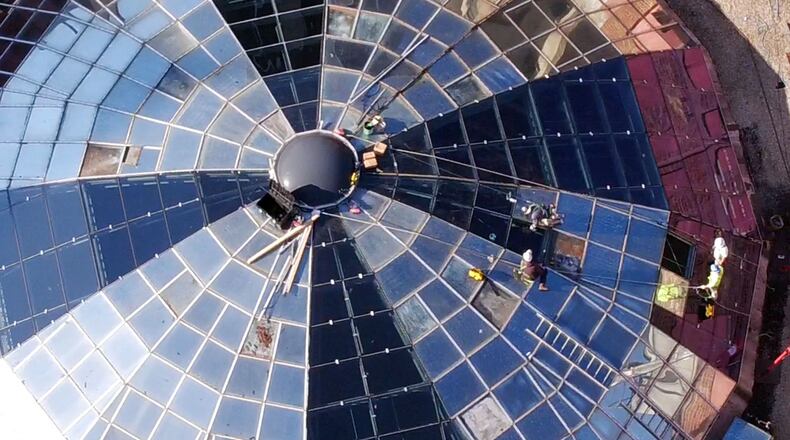The second phase will rehab two buildings on the north end of the nine-building complex, which could be a $28 million to $30 million investment, Williams said.
“It’s all about the money, and if the money isn’t there, we aren’t going to do the project,” he said. “These sources, at all levels, are hugely critical.”
State historic tax credits are highly competitive, and 44 other Ohio projects also are seeking tax incentives, notably including two in Dayton, the J.K. McIntire and the Barclay buildings.
Woodard Development, a leading downtown developer, plans to convert the long-vacant McIntire building at 601 E. First St. in to offices and “innovative technology hub.” The new owners of the Barclay Building at 137 N. Main St. hope to turn the office building into a boutique hotel.
MORE: Dayton Arcade survived ‘near-death’ moments
The Dayton Arcade was one of three Dayton projects to apply for state historic tax credits in the current funding round.
Developers are seeking $2.75 million to rehab the north arcade, which consists of the Third Street arcade and the Gibbons Annex buildings.
The Third Street arcade is a two-story, sky-lit retail arcade that has a distinctive Flemish facade, according to developers.
The Third Street arcade was renovated and modified in 1980 to create an indoor mall that operated until the arcade complex closed in 1991.
The second floor will have offices overlooking the arcade, and the upper levels of the five-story Gibbons Annex will be turned into new apartments — mostly micro units intended to provide affordable housing to students and young professionals.
The first floor of the Third Street building will become a shared-use commercial kitchen.
Shared commercial kitchens provide chefs, bakers, food truck operators and other culinary entrepreneurs with access to what can be expensive food preparation equipment, like ovens, grills, steamers, fryers and broilers.
"Basically you are a member of the kitchen, and for that you get access to the amenities of a commercial kitchen," said Frances K. Mennone, director of development of developer Cross Street Partners.
MORE: Dayton Arcade beginning to look a lot like 1904 building
The arcade project, described as one of the most complicated deals in Dayton’s history, has many sources of funding, including state and federal historic tax incentives. Unlike federal historic tax credits, state incentives are competitive.
The arcade was awarded $5 million in historic preservation incentives in June 2017 to help finance the rehab of the iconic Rotunda, and the Commercial and Lindsey buildings.
Six months later, the state awarded $4 million more in tax credits that will help rehab the seven buildings that make up what is called the south arcade (meaning south of an alley that breaks up the interconnected buildings).
The state awards up to $5 million in state historic tax credits per project, but the arcade developers are seeking less than that in the hopes it will make their application more competitive.
Time kills deals, and failure to win tax credits in this round would likely delay the financing package for the north arcade by about six months, at least until the next round of awards are announced next summer, said Williams.
MORE: Dayton Arcade deal closes, city leaders celebrate
The redevelopment of the arcade had a setback in late 2016 when its application requesting $5 million in credits was narrowly beaten out by other projects, including the Centre City building at 40 S. Main St. in downtown, which won $5 million in incentives, according to state scoring data obtained by this newspaper.
The Centre City project failed to move forward and eventually forfeited its credits. The arcade was allocated credits six months later, but the timing resulted in additional “carrying costs” and impacted the assembly of the financing package, causing delays, developers said.
The state is unlikely to allocate funding to projects if they do not have a ratio of 10-to-1 for the cost of the investment versus the amount of the credits being sought, Williams said.
“We chose the number we chose, because we wanted a winning application,” he said.
The state historic tax credit program is extremely important, and without it, much of the revitalization taking place in Dayton and other urban areas around the state would not be possible, Williams said.
MORE: Through the years: Downtown Dayton Arcade
Also in Dayton, the Barclay Building is seeking $2.4 million in historic preservation tax credits and the J.K. McIntire building has requested nearly $1.7 million.
This newspaper in July revealed that the new owners of the 10-story Barclay property hope to turn it into a new hotel that is part of the Tapestry Collection by Hilton. Hilton confirmed that a Tapestry Collection property in Dayton is slated to open in 2021.
First Barclay LLC purchased the building last year, which was home to Miller-Valentine Group, and announced its intention to convert it to a branded boutique hotel. The company is a partnership between Columbus-based Lawyers Development Corporation and Chicago-based First Hospitality Group.
Late last month, Woodard Development announced it is rebranding the six-story J.K. McIntire building as the Manhattan, which will be transformed into new offices.
MORE: Downtown Dayton could get Hilton Tapestry boutique hotel
Two growing companies have committed to occupying space in the 55,000-square-foot structure, which is currently vacant.
Mile Two plans to take up multiple floors, while Battle Sight Technologies expects to use about 5,000 square feet of space.
“We are optimistic this will be another great revitalization project, breathing new life into a historic building for Downtown Dayton,” said Jason Woodard, principal of Woodard Development.
MORE: Big downtown Dayton developer to turn empty property into offices
About the Author

